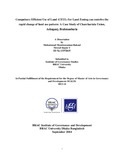| dc.contributor.advisor | Ahmed, Dr. Nasiruddin | |
| dc.contributor.author | Bakaul, Mohammad Moniruzzaman | |
| dc.date.accessioned | 2015-11-29T05:10:21Z | |
| dc.date.available | 2015-11-29T05:10:21Z | |
| dc.date.copyright | 2014 | |
| dc.date.issued | 2014-09 | |
| dc.identifier.other | ID 13372015 | |
| dc.identifier.uri | http://hdl.handle.net/10361/4655 | |
| dc.description | This thesis is submitted in partial fulfillment of the requirements for the degree of Masters of Arts in Governance and Development, 2014. | en_US |
| dc.description | Cataloged from PDF version of thesis report. | |
| dc.description | Includes bibliographical references (page 82 - 86). | |
| dc.description.abstract | Bangladesh is one of the most densely populated country in the world. With the growing
population, and their rising needs in diverse sectors, land use patterns are undergoing a
quantitative and qualitative change in which the areas under the net cultivable land, water bodies
and forest land is gradually shrinking. Besides, unplanned infrastructure development is
devouring productive land. In Bangladesh, about 1% of agricultural land in each year is
transferred to another use (SFYP, 2011). If this process continues, all of our agricultural land
would diminish within 100 years (Tariquzzaman, 2009). This terrible situation is very crucial for
an agro-based economy. The Ministry of Land formulated a National Land Use Policy in 2001 to
ensure best possible use of land resources for sustainable development. The policy highlighted
the need for carrying out a National Land Zoning Program for integrated planning and
management of the country’s land resources. Planned use of land according to Land Zoning
Maps prepared on the basis of present and potential land uses will be ensured through
enforcement of the provisions of relevant laws. The current research is an attempt to study the
pattern of land use change and agricultural land transformation at Charchartala union in Asuganj
Upazila, Brahmanbaria. The research also analyzed the land zoning process and established a
logical approach for saving cultivable land, planned land use and systematic development.
Compulsory Efficient Use of Land (CEUL) is the most accountable and feasible systematic
approach for favorable land use and planned land zone in Bangladesh. CUEL is related to
various quantitative and qualitative aspects of land resource. Holding different cartographic
information, CUEL facilitates capturing, retrieval, and querying of information and provides
tools to perform different analyses. Based on the primary and secondary data, this research is
aimed at studying the synchronization and diachronization of land use pattern, and
recommending feasible interventions and strategy of CUEL for creating an efficient and planned
land use policy for Bangladesh. | en_US |
| dc.description.statementofresponsibility | Mohammad Moniruzzaman Bakaul | |
| dc.format.extent | 172 pages | |
| dc.language.iso | en | en_US |
| dc.rights | BRAC University dissertation are protected by copyright. They may be viewed from this source for any purpose, but reproduction or distribution in any format is prohibited without written permission. | |
| dc.subject | MAGD | en_US |
| dc.subject | Land use | en_US |
| dc.subject | Case study | en_US |
| dc.title | Compulsory Efficient Use of Land (CEUL) for Land Zoning can contrive the rapid change of land use pattern: A Case Study of Charchartala Union, Ashuganj, Brahmanbaria | en_US |
| dc.type | Thesis | en_US |
| dc.contributor.department | BRAC Institute of Governance and Development, BRAC University | |
| dc.description.degree | M. Governance and Development | |

